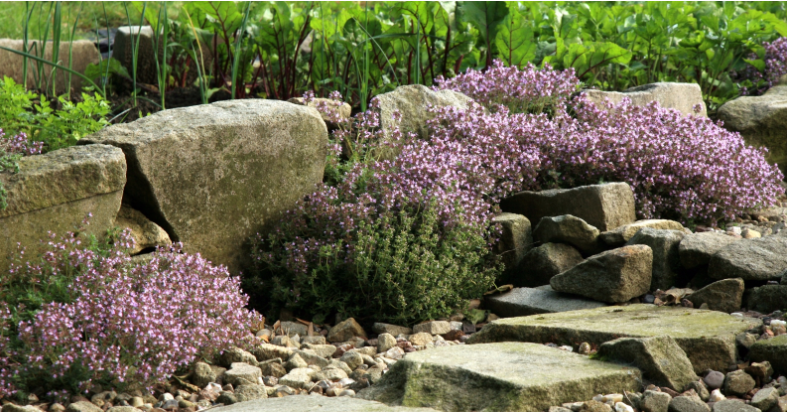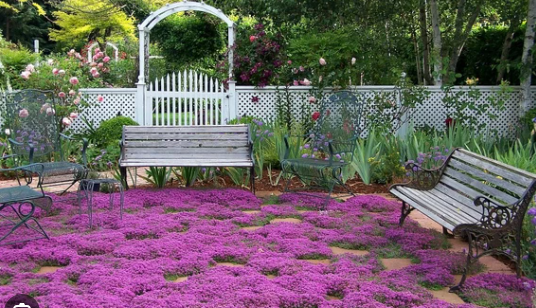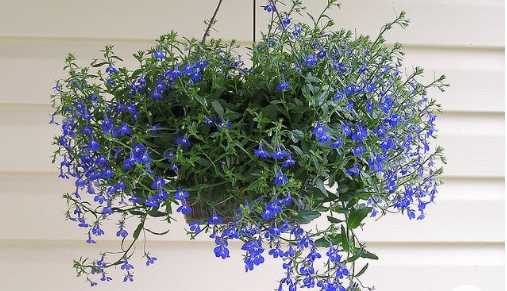
Thymus serpyllum, commonly called wild thyme, creeping thyme or mother-of-thyme, is a hairy, prostrate, creeping, woody-based perennial which is primarily grown as an ornamental ground cover. It is native to Europe, western Asia and northern Africa.
The leaves of creeping thyme are typically oval-shaped and arranged oppositely along the stems. They are small, measuring approximately 1/4 to 1/2 inch in length, and feature a rich green color with a slightly fuzzy texture. The leaves emit a pleasant fragrance when crushed, releasing the distinct aroma associated with thyme, which is often described as earthy, herbal, and slightly spicy.
Creeping thyme produces slender, trailing stems that sprawl along the ground and root at the nodes, allowing the plant to spread and form a dense mat. These wiry stems are flexible yet durable, enabling creeping thyme to withstand light foot traffic without damage. As the plant matures, the stems may become woody at the base while remaining supple and green toward the tips, where new growth emerges. Along the stems, clusters of tiny flowers appear in late spring to early summer, adding a burst of color to the landscape. The flowers, which are typically pink, purple, or white, arise in dense terminal spikes and attract pollinators such as bees and butterflies.
The size of creeping thyme can vary depending on factors such as growing conditions, variety, and maintenance practices. Generally, creeping thyme reaches a height of only a few inches, typically ranging from 2 to 4 inches tall at maturity. However, its trailing stems can extend outward considerably, covering a substantial area as they root at the nodes and spread.
Genus name comes from the Greek word thymos (name used in ancient Greece for a species of Thymus or Satureja). Specific epithet from Greek means creeping in reference to the trailing growth habit of this species.
Numerous cultivars of this species have been described, featuring plants of varying sizes (creeping to upright), varying flower colors (white, pink, red or purple), and varying foliage colors (dark green to gold to variegated).
Landscaping Ideas for Creeping Thyme
Stepping Stone Path Borders

Plant creeping thyme along the edges of stepping stone paths to soften the hardscape and create a charming, fragrant border. The low-growing nature of thyme will fill in the gaps between stones beautifully.
Rock Garden Accent

Integrate creeping thyme into rock gardens to provide a soft contrast to the rugged textures of rocks. Plant it in crevices and gaps between rocks, allowing it to cascade over the edges for a natural, organic look.
Slope Stabilization

Utilize creeping thyme on slopes or embankments to help control erosion. Its trailing habit helps to stabilize soil while providing a lovely carpet of greenery.
Ground Cover for Pavers

Plant creeping thyme between pavers in patios or walkways. It will create a lush, low-maintenance ground cover that releases a pleasant scent when stepped on.
Border for Raised Beds

Line the edges of raised garden beds or planters with creeping thyme. This adds a soft, cascading element to the structure while also attracting pollinators to nearby vegetables or flowers.
Fairy Garden Accent

Create miniature landscapes or fairy gardens by planting creeping thyme around miniature structures, such as tiny cottages or gnome statues. Its diminutive foliage adds to the magical atmosphere.
Living Mulch

Use creeping thyme as a living mulch around trees, shrubs, or garden beds. Its dense growth helps suppress weeds, retain moisture in the soil, and provide a decorative ground cover.
Hanging Basket Filler

Plant creeping thyme in hanging baskets alongside other trailing plants like ivy or trailing petunias. Its cascading growth habit will spill over the edges of the basket, creating a lush display.
Edging for Herb Gardens

Define the edges of herb gardens with creeping thyme. Its aromatic foliage complements culinary herbs like rosemary, sage, and basil while providing a practical and attractive border.
Underplanting for Trees

Underplant trees with creeping thyme to create a lush, green carpet beneath the canopy. This not only adds visual interest but also helps to suppress weeds and conserve moisture in the soil.
How To Grow And Care For Creeping Thyme
Site Selection
Choose a planting location that receives full sun to partial shade. Creeping thyme thrives in well-draining soil with a pH level between 6.0 and 8.0. It’s crucial to ensure good drainage to prevent waterlogged conditions, which can lead to root rot.
Planting
Creeping thyme can be propagated from seeds, cuttings, or nursery-grown plants. If starting from seeds, sow them indoors in early spring or directly in the garden after the last frost date. Space plants about 6 to 12 inches apart to allow for spreading. Gently press seeds into the soil surface and keep them consistently moist until germination occurs.
Watering
Once established, creeping thyme is moderately drought-tolerant and prefers slightly dry conditions. Water newly planted thyme regularly to help establish a strong root system. Afterward, water only during prolonged dry spells or when the soil feels dry to the touch. Avoid overwatering, as it can lead to root rot.
Fertilization
Creeping thyme is a low-maintenance plant that generally doesn’t require regular fertilization. If your soil is poor or lacking in nutrients, you can apply a balanced fertilizer in spring, following the package instructions carefully. However, avoid over-fertilizing, as this can promote excessive foliage growth at the expense of flowering.
Pruning and Maintenance
Regular pruning helps to keep creeping thyme neat, compact, and encourages dense growth. Trim back any dead or leggy stems in spring or after flowering to maintain its shape. You can also shear the plant lightly after flowering to promote bushiness and prevent it from becoming woody. Additionally, removing spent flowers can prolong the blooming period.
Mulching for those growing in containers
Applying a thin layer of mulch around creeping thyme plants can help conserve soil moisture, suppress weeds, and regulate soil temperature. Use organic mulches like shredded bark, compost, or straw, but avoid piling mulch directly against the stems, as this can promote rot.
Winter Protection
In colder climates, creeping thyme may benefit from some winter protection to survive freezing temperatures. Apply a layer of mulch around the plants in late fall to insulate the roots and reduce the risk of frost heaving. You can also cover the plants with a floating row cover or burlap if temperatures drop significantly.
Pest and Disease Management
Creeping thyme is relatively resistant to pests and diseases, but occasional problems may occur, such as aphids, spider mites, or powdery mildew. Monitor plants regularly for signs of infestation or disease, and treat promptly with insecticidal soap or fungicides if necessary. Avoid overhead watering to prevent fungal issues.